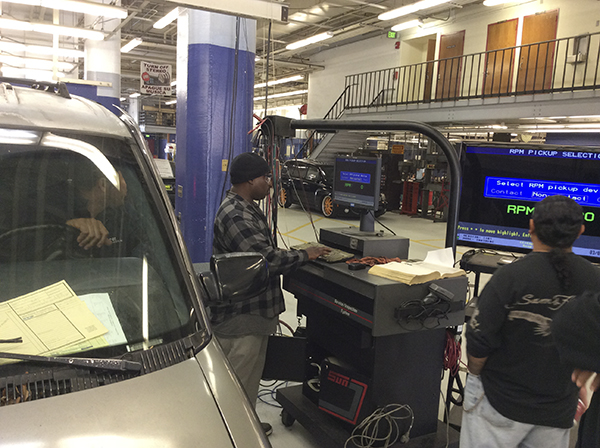Low pressure-Fuel Evap-Test
Lowpressure-FuelEvap-Test
The Low Pressure Fuel Evaporative Test (LPFET) shall be performed on all 1976-1995 model-year vehicles (based on chassis model year) with the exception of the following:
• Vehicles not originally equipped, and not required by state or federal law to be equipped, with a fuel evaporative control system;
• Vehicles with two or more fully operational fuel tanks;
• Vehicles powered exclusively by diesel, compressed natural gas (CNG), liquefied natural gas (LNG), or liquefied petroleum gas (LPG);
• Vehicles for which there are no fuel LPFET filler neck adapters;
• Vehicles in their original factory configuration, with a fuel evaporative canister and fuel vapor hoses that are not accessible or would require the partial dismantling of the vehicle in order to gain access to them for testing. The inspector shall note the vehicle’s canister location on the Vehicle Inspection Report for these vehicles.
• Vehicles with single fuel tanks greater than 50 gallon capacity.
Lowpressure-FuelEvap-Test

Lowpressure-FuelEvap-Test
Inspectors shall enter “N” at the EIS Fuel Evaporative Test prompt when inspecting any of the vehicles listed above.
Inspection: Smog Check stations and Smog Check inspectors shall perform the low pressure test of a vehicle’s fuel evaporative systems, using a BAR certified low pressure fuel evaporative tester (LPFET). The test shall be performed in accordance with the test procedures and specifications contained in the LPFET instruction manual provided by the tester manufacturer, and the following, as applicable:
• If components related to the vehicle’s fuel evaporative system tank side are missing, modified, disconnected, or defective enter “N” (not applicable) at the EIS Low Pressure Fuel Evaporative Test prompt. If the vehicle’s tank side fuel evaporative system components are not missing, modified, disconnected, or defective proceed with the test. Tank side means the portion of the fuel evaporative system between the canister pinch or seal point and the fuel tank filler neck. (Tank side visual inspection failures can affect the LPFET. Therefore, in cases where a tank side visual inspection failure exists, the LPFET does not apply).
Note: Evaporative system visual inspection results must be entered at the EIS Evaporative System Visual Inspection prompt;
• At the conclusion of the test, the LPFET displays a P (pass), enter P in the EIS at the Fuel Evaporative Test prompt.
• At the conclusion of the test, the LPFET displays an F (fail), perform a seal check in accordance with the procedures and specifications contained in the LPFET instruction manual provided by the tester manufacturers.
B.A.R. Website
CLASS SCHEDULES
Emission Control 1:
B.A.R. Smog Check
Inspector Level 1
(Inspector "Smog" License):
Engine Fundamentals
8am - 12:15 pm
Summer Class
7/5/2022 -8/5/2022
Class # 799065
Emission Control 2:
B.A.R. Smog Check
Inspector Level 2
(Inspector "Smog" License):
Rules and Regulations
8am - 12:15 pm
Summer Classes
7/5/2022 - 8/5/2022
Class # 799067
Engine Performance 1:
8am - 12: 15 pm
Date: TBD
Class # 799069
Engine Performance 2:
B.A.R. Specified Diagnostic
and Repair Training
(Repair "Smog" License)
Time: TBD
Date: TBD
Class # 799071
Emission Control 1
(Inspector "Smog" License):
5:00pm - 8:45 pm
Date: TBD
Class # 799065
Emission Control 2:
(Inspector "Smog" License):
5:00pm - 8:45 pm
Date: TBD
Class # 799065
Exhaust Emissions (Update Class):
5:30 pm - 8:45 pm
Tuesday nights:
Dates: coming soon
Class # 796070